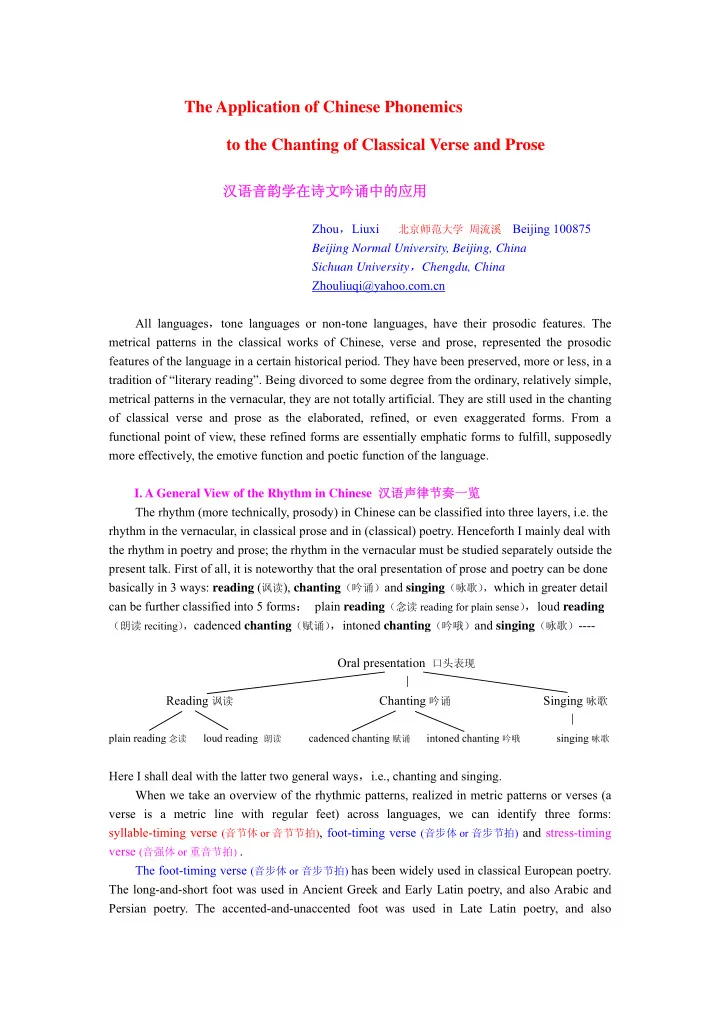

The Application of Chinese Phonemics to the Chanting of Classical Verse and Prose 汉语音韵学在诗文吟诵中的应用 Zhou , Liuxi 北京师范大学 周流溪 Beijing 100875 Beijing Normal University, Beijing, China Sichuan University , Chengdu, China Zhouliuqi@yahoo.com.cn All languages , tone languages or non-tone languages, have their prosodic features. The metrical patterns in the classical works of Chinese, verse and prose, represented the prosodic features of the language in a certain historical period. They have been preserved, more or less, in a tradition of “literary reading”. Being divorced to some degree from the ordinary, relatively simple, metrical patterns in the vernacular, they are not totally artificial. They are still used in the chanting of classical verse and prose as the elaborated, refined, or even exaggerated forms. From a functional point of view, these refined forms are essentially emphatic forms to fulfill, supposedly more effectively, the emotive function and poetic function of the language. I. A General View of the Rhythm in Chinese 汉语声律节奏一览 The rhythm (more technically, prosody) in Chinese can be classified into three layers, i.e. the rhythm in the vernacular, in classical prose and in (classical) poetry. Henceforth I mainly deal with the rhythm in poetry and prose; the rhythm in the vernacular must be studied separately outside the present talk. First of all, it is noteworthy that the oral presentation of prose and poetry can be done basically in 3 ways: reading ( 讽读 ), chanting (吟诵) and singing (咏歌) , which in greater detail can be further classified into 5 forms : plain reading (念读 reading for plain sense ) , loud reading , cadenced chanting (赋诵) , intoned chanting (吟哦) and singing (咏歌) ---- (朗读 reciting ) Oral presentation 口头表现 | Reading 讽读 Chanting 吟诵 Singing 咏歌 | plain reading 念读 loud reading 朗读 cadenced chanting 赋诵 intoned chanting 吟哦 singing 咏歌 Here I shall deal with the latter two general ways , i.e., chanting and singing. When we take an overview of the rhythmic patterns, realized in metric patterns or verses (a verse is a metric line with regular feet) across languages, we can identify three forms: syllable-timing verse ( 音节体 or 音节节拍 ) , foot-timing verse ( 音步体 or 音步节拍 ) and stress-timing verse ( 音强体 or 重音节拍 ) . The foot-timing verse ( 音步体 or 音步节拍 ) has been widely used in classical European poetry. The long-and-short foot was used in Ancient Greek and Early Latin poetry, and also Arabic and Persian poetry. The accented-and-unaccented foot was used in Late Latin poetry, and also
Germanic and Slavonic poetry. The stress-timing verse ( 音强体 or 重音节拍 ) was used in Old Germanic poetry; and later it became the prevailing form of English poetry. The rhythmic group (loosely, a foot) is composed of a stressed syllable with one or more unstressed syllables. The syllable-timing verse ( 音节节拍 ) was used in Romance languages, Celtic languages and many Asian languages. In China it was widely used from the pre-Qin period all the way down to the Six Dynasties. In the pre-Qin period, the main verse form was the quadric-syllabic verse ( 四言 诗 ) , as seen in The Book of Songs ( 《诗经》 ) : 关关雎 鳩, 在河之洲。窈窕淑女,君子好逑。 參 差荇菜,左右流之;窈窕淑女,寤寐求之。 求之不得,寤寐思服;悠哉悠哉,展 轉 反 側。… A later example is the poem Duange-xing ( ) by Cao Cao. Occasionally, long verse with a 《短歌行》 caesura (mainly, the tune particle 兮 ) could be used, as in Yishui-ge ( ) by Jing Ke: 《易水歌》 风萧萧兮/易水寒,壮士一去兮/不复还! And Dafeng-ge ( ) by Liu Bang: 《大风歌》 大风起兮/云飞扬。威加海内兮/归故乡。安得猛士兮/守四方! Actually, Dafeng-ge belongs to the category of poems and songs of the Chu style. There is a ) by Qu Yuan rich collection of such works in the Chu Poetry ) , of which the Lisao ( 《楚辞》 ( 《离骚》 is the best masterpiece. Then the general vogue shifted to pent-syllabic verse (五言诗) in the Han Dynasty. A typical set of 19 anonymous poems have been regarded as its models; e.g. 明月何皎皎,照我罗床帏。忧愁不能寐,揽衣起徘徊。客行虽云乐, 不如早旋归。出户独彷徨,愁思当告谁?引领还入房。泪下沾裳衣。 This was held as a norm of classical style through centuries until the Tang Dynasty at least. Li Bai’s Ziye-qiuge ( ) is an example: 《子夜秋歌》 长安一片月,万户 搗 衣声。秋风吹不尽,总是玉关情。 何日平胡虏,良人罢远征? ): See also the poem by the monk Jiaoran for a visit in vain ( 《寻陆鸿渐不遇》 移家虽带郭,野径入桑麻。近种篱边菊,春来未著花。 扣门无犬吠,欲去问西家。报道山中去,归时每日斜。 To come back to the Han Dynasty--- in its late years (1 st century onward), Buddhism was introduced to China, together with the translation of its sutras documents. In the search for most equivalent sinograms ( 汉字 , a sinogram is pronounced as a syllable) in the translating (and also chanting) of the sutras, Indian ś abdavidy ā ( 声明学 ) , i.e., philology (including phonology), began to make its way into China in a time not later than the 3 rd century. In the 5 th century (in the Qi Dynasty of south China) , poets and writers often had friendly contacts with foreign or Chinese monks in Buddhist conventions , where they listened to the singing of Buddhist brahma-p ā t ha (Chinese . version) , which imitated, to some extent, the Sanskrit intonation (as in veda chanting) in three tones: ud ā tta (high), svarita (falling), anud ā tta (low), occasionally plus anud ā ttara (lower). From time to time they discussed the appropriate transliteration of Sanskrit syllables by sinograms. In so doing, they were greatly inspired by Sanskrit pronunciation and intonation (although indirectly), and began to recognize the existence of tones in Chinese (and to see also the essential combination of the onset and rime in sinogram syllables). They identified the four tones as pingsheng ( 平 level tone) , shangsheng ( 上 rising tone) , qusheng ( 去 departing tone) , plus the entering tone ( 入 with an abrupt coda, holding corresponding tone levels of the other three tones) . These tones,
Recommend
More recommend